Sean Jacobs's Blog, page 561
February 21, 2012
Paris is a Continent N°9
Watching French incumbent president Nicolas Sarkozy's speech in Marseille Sunday night (his second speech since announcing he's seeking a second term last week), I was hoping for a reference to how the financial crisis — the millstone round Europe's neck, a politician's nightmare — has hit the banlieueus. I should have known better. His words on the European financial crisis referenced the "Greek civil servant with his salary cut" and "the Portuguese retiree with his pension cut" but "France was not swept away by a crisis of confidence". He's talking confidence in the French economy, not in his person. Presenting himself as the country's savior ("I've avoided France from a catastrophe"), he showed himself the 'respectable' fanatic people have started to suspect him to be. Anyway, what I'm trying to say is this: there's a whole world in between the Champs-Elysées and Greece. It burned in 2005, as French-Cameroonian rapper Mac Tyer reminds us in his new 'Justice' video, and it has been left smoldering since.








South Africa's TRC on film
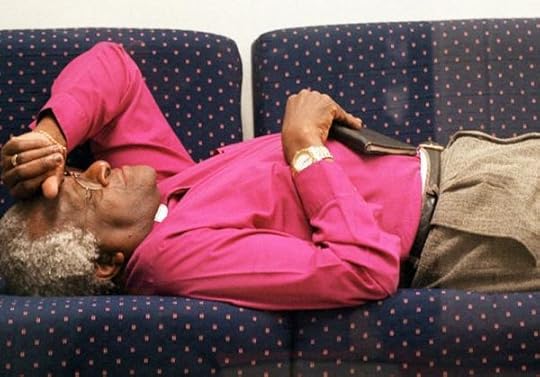
It has recently been announced that Roland Joffe, (Londoner and) director of films The Mission and The Killing Fields has cast Forest Whitaker to play Archbishop Desmond Tutu in his upcoming film. In an adaptation of Michael Ashton's play inspired by the events at the Truth and Reconciliation Commission in South Africa, the film — titled The Archbishop and the Antichrist — imagines a meeting between Tutu and 'boorish white mass murderer' Piet Blomfeld. Shadow and Act blog did some digging and found this synopsis of the play, which points toward somewhat banal complications of the TRC already addressed in a variety of other films, such as the questioning of rehabilitative justice instead of punitive justice, the subjective notion of 'truth', and redemption and reconciliation for whom exactly?
The casting of Whitaker is interesting, especially since his performance as Idi Amin in The Last King of Scotland. He's not intimidated by well known historical figures; but the impish, slight figure of Tutu seems to be a far cry from Whitaker's usually powerful and pumped characters; the enigmatic Ghost Dog in the eponymous film (1999), Amin in The Last King of Scotland (2006), or Jake in Repo Men (2010).
Films dealing with the TRC often get caught up in self-aware complications of the central notions that plagued the commission. From the synopsis on Shadow and Act, it seems that Joffe will follow in the not-so-subtle footsteps of films such as In My Country, a film by John Boorman based (very vaguely) on Antjie Krog's book Country of My Skull; a beautiful, poetic and complicated account of her time working for SABC radio, which is unfortunately Hollywood-ised beyond recognition by the film. Binoche as Krog is a stilted, confused performance; her French accent is off-putting, and the unbelievable exchanges on morality and redemption with co-star Samuel L Jackson as a picky American reporter are misplaced and crude. Similarly, Red Dust (2004), by Tom Hooper starring Hilary Swank, Jamie Bartlett and Chiwetel Ejiofor is a predictable, bland portrayal of the TRC.
It is the more oblique, sideways glances at the TRC that seem to better understand its endless nature; the multiple truths and effects that it produced in 'the new' South Africa. Ramadan Suleman's film Zulu Love Letter (2004) is a brilliant examination of truth, speechlessness, and a haunting political past. Using surreal sequences to depict the protagonist, Thandi's (Pamela Nomvete Marimbe) sense of isolation from the present, and, from the past, Suleman portrays her as suspended within post-Apartheid society, unable to reconcile the past, and unable to move forward into the 'new' South Africa. The TRC forms the suggestive moral backdrop of the film, and benefits from this approach. This is similarly approached in Ubuntu's Wounds (2002), a short film by Sechaba Morojele that complicates ideas of revenge, redemption and reality. What is brilliant about this film is that it mirrors the way most South Africans would have encountered the TRC, on television; the protagonist, Lebo, is traumatized by his wife's murder, and while watching her killers disclosure at the TRC on a television in LA, the film dissolves the multiple fronts of the TRC; television, testimony and witness are boiled down into one raging human being, unable to escape apartheid's ghosts.
I fear the worst for Joffe's new film, but I'll readily be surprised by Whitaker as a convincing Tutu. As past films testify, the Truth and Reconciliation Commission — although it possesses all the intrigue, power and excitement of a courtroom-style drama like 12 Angry Men — has invariably been sensationalised into a showcase of trauma-as-entertainment. We'll have to wait and see how this one turns out…








February 20, 2012
Necessary doses of pan-Africanism: Esperanza Spalding's "Black Gold"
It's not too late to take your vitamins. And this. Jazz bass player and bandleader Esperanza Spalding, who defeated Bieber nation last year, takes on school curriculum and Black History Month with the song "Black Gold," the single from her album "Radio Music Society." She gets some help from vocalist Algebra Blessett. We'll forgive the little boy for going on about Africa has "86 countries." A more pressing issue: Where can I get that book the dad is flipping through? And that's your #MusicBreak.








Sindiso Nyoni's Riot Art
Short recent video profile by VOA's Nico Colombant of the Zimbabwean artist, illustrator and designer R!OT (also known as Sindiso Nyoni).








Do people believe ex-prisoners can change their ways?
That was the question asked to people in Cape Town, South Africa, by the Prison Broadcasting Network (PBN), "a non-profit rehabilitation programme that teaches prisoners the skills to become employable when they are released." I found the responses unsurprising. But the video has a twist.
There's also this, as pointed out by Osocio, the blog that monitors non-profit advertising and marketing: (spoiler alert) "It's a shame, though, that we didn't get to see this fact revealed to the interview subjects themselves. Watching their reactions would have made this much more memorable."








The Tour of Rwanda

A series by photographer Mjrka Boensch Bees about the 2011 cycling tour in Rwanda. (Remember Philip Gourevitch's essay on the 2010 edition.) Here.








Photography. The Jews of Morocco
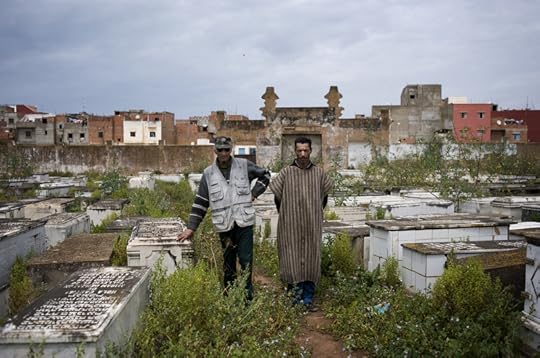
Aaron Elkaim is a documentary photographer based in Toronto. He studied Film and Cultural anthropology before deciding to pursue photography. With four other Canadian photographers, he founded the Boreal Collective. His photo-essay "Exodus," which won second prize in the 2010 Viewbook Photostory documentary competition, explores the remains of the Jewish communities in Morocco. He documents personal and familial narratives, archival and architectural remains of Jewish communities in modern-day Morocco. The accompanying notes mention that the Jewish community was founded over two thousand years ago, prospered for centuries, and grew to occupy a proud place within Moroccan national identity.
[image error]
Could you explain how you discovered this history, and outline the motivations behind your decision to engage with it?
I discovered this history while researching my own family history. My father was born in Marrakech and immigrated to Canada in the 1960's with most of his family. I was primarily raised with my mother, and didn't have much frame of reference to my Moroccan Jewish ancestry. My desire to learn more is what led me to my research.
Initially I was interested in the fact that the community there seemed to be disappearing. In my mind I though about an old Jewish culture and community that was about to disappear, and thought that for this reason it was important to go there and document it before it was gone. In hindsight this approach would have been very one-dimensional … that romantic ideal I was visualizing was mostly already gone and replaced by the modern world.
It took me some time before I began to see what the story would eventually become, about the positive history that existed between the Muslim and Jewish cultures in Morocco. The more I explored and the more I learned I began to see how this history did not seem to fit into the modern day reality of Muslim and Jewish relations that is presented in the mainstream. For me this history was a shining light in an otherwise dark world, this is what became my motivation.

The images are strikingly varied, recording religious and social ritual, personal conversations, individual portraits, cataloguing objects and describing landscapes. Could you explain how this project was organised, and how the images relate to your trip(s) to Morocco?
This project takes place over two separate trips. The first trip was one month in 2009 with my father and was mostly exploratory. I had ideas floating around before I got there, but only once I was there was I confronted with the seeds of the story. Once back home in Canada I began to think about how I would further develop the story on my return … When I returned the next year I gave myself three months to work. I knew I wanted to explore old sites and photograph Muslim guardians of Jewish sites; I also wanted to document the remaining community in their daily life and rituals. Visiting sites was the easy part as I could find out where they were and simply go there. When I work I try to always follow my gut. I try to meet as many people I can and never try to force pictures out of my encounters, but always try to be ready for when the picture reveals itself to me.
For the final organization of the work, I do most of that in the edit. Certain images that I may have thought would be essential to the story when captured are often discarded in the edit. When I photograph I am simply collecting fragments of the story, pieces of the puzzle. The edit is putting those pieces together and creating the final image. I do photograph with a rough plan and when the photos stop coming I return to that plan, but I am usually seeing where the path leads me rather than trying to pre-construct too much.
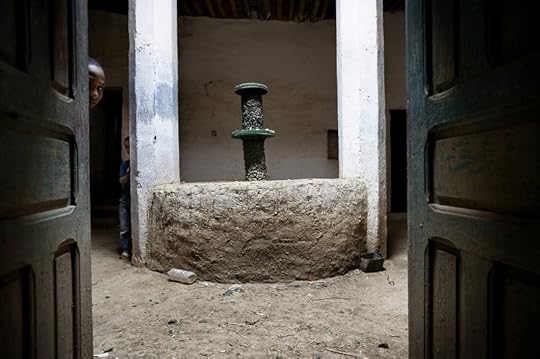
You quote the words of King Mohammed V, asserting against the wishes of fascist Germany, that "We have no Jews in Morocco, only Moroccan citizens." Yet you note that the star of David was removed from the flag due to a request from an anti-semitic French government. One way in which you explore the complex relationships between Morocco, Europe and the Jewish diaspora is through attention to the guardians of the Jewish heritage in Morocco, who are mostly not Jewish. Some of these images describe tensions which mostly arise, it seemed, due to economic relations. Could you tell us a little more about your encounters with them?
During my first trip to Morocco I visited the Al Zama Synagogue in Marrakech and met a Muslim lady who lived there. She cooked, cleaned and lived alongside the Jews who were also living at or visiting the synagogue. In many ways they seemed like family and maintained a close and amicable relationship. It was here that I was inspired to focus on the guardians as an aspect of my story. As I moved around the country I found a wide range of different situations these guardians were in. Financially speaking I found that most of these guardians were not paid directly by any Jewish Organization but received donations from visitors. Some lived in very remote areas where visitors were rare, and likewise donations were sparse. Each guardian had their own personal history with the Jewish people. Some of these people had close relations with the Jewish community before they had left and were therefore entrusted to care for the sites after the last Jews left. Often it would be the children who had taken over after their parent, the previous guardian, had passed on. Overall there was a sense of admiration for the Jewish community whom they had lived alongside.
In one instance a man who had been guardian of a cemetery living on site raising animals with his family since 1955 was going to be evicted by the Jewish community who wanted to develop the land where they lived. His son had ill feelings towards the Jewish community, believing his father had given them his life and they had given nothing back in return. The father, on the other hand, seemed to remember the Jews he once lived alongside with such reverence that he held no ill feeling towards them and seemed to maintain a sense of pride for the work he had done. Another man I had met in Ksar el-Kebir had immense pride for his job of guarding a cemetery and a Jewish saint who rested there. This particular saint was quite revered and there were annual pilgrimages to his site that the guardian was always involved with. Often Jewish and Moroccan dignitaries would attend these events and the guardian felt truly appreciated. He also grew up as close friends with some revered members of the Jewish community. At another pilgrimage in Ouazzane the guardian there would sing songs in Hebrew with visiting Jews during their celebrations, it was quite inspirational.
One thing I wonder though is how the younger generation will feel towards the Jews as the older generation who once lived alongside them pass on. Will they fall into the dichotomy of the modern world?
On your website, you suggest it is the aim of photography to "urge the viewer to ask more questions and seek more answers." Is this project consciously engaging with an existing literature or debate? If so, where and how does this project access a community of viewers?
Yes, I believe it does. It engages with the debate of what it means to be Jewish and the question of homeland. Zionism has framed the Jewish identity through its Biblical and historic connection to Israel and their persecution during the holocaust. Morocco is a place where Jews lived for thousands of years; these Jews formed a unique culture and identity that was shaped by their relationship to the land and their neighbors (Arab, Muslim and Berber). They were also protected during the holocaust by their Muslim King.
Currently, the overriding narrative in the Middle East concerns Palestine and Israel. This narrative boils down to Muslims against Jews, but when you look at histories such as that of Morocco, we see that, with the black and white approach of simply boiling down identities and histories into "us and them," we lose all the shades of grey, and it is in these that we find the tones of truth and understanding. That is what I am hoping to reveal and I hope to urge viewers to seek more answers, to find those shades of grey. We all too often stick to one camp or the other (pro/anti), but truth and hope lies in the cracks in-between.

There appears to be an argument made in the series about the potential for multi-faith and multi-ethnic communities to prosper in modern cities and nation states. That is partly why this anthropology seems so optimistic. Against this, however, there is a more recent problem, for the Jewish diaspora in particular, which is the pressure exerted by international geo-politics (Zionism; Israel) on local community relations. Is this part of an ongoing inquiry in your work?
I am really not trying to make any sort of an argument. With my work I hope to share my perspective and a story, the viewers will hopefully come to their own conclusions. The history of Morocco is not the modern world; today things are very different in regards to international power struggles, ideologies, and propagandas. I do however try to be idealistic and search for hope that the world can change for the better, that humans are capable of understanding one another and finding ways of working and living together. I believe this is seen in Morocco and its history, yet I am not pretending that the history there was perfect and problem free, the important thing is that it worked.
For the second part of your question, there is indeed a pressure exerted on the diaspora Jewish communities by international geo-politics, and it is these communities whom I hope are inspired by this story to look deeper at the histories rather than be persuaded by propaganda and nationalistic or faith based loyalties.
* Elkaim's work has been published in a number of on-line publications and blogs and has also been exhibited at multiple international photography festivals. It will also be shown in a solo show at the Pikto Gallery in Toronto during the 2012 Contact Photography Festival.








February 18, 2012
Campaigning: Reporters Without Borders
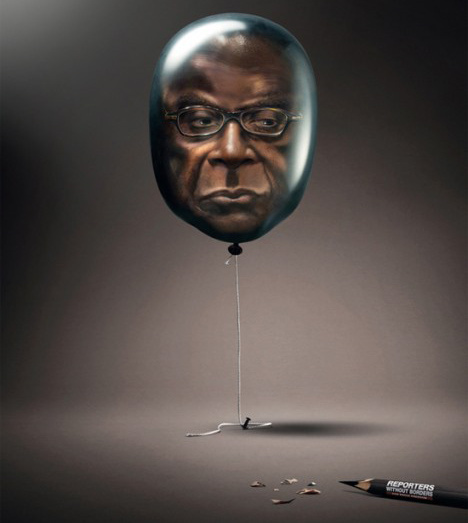
The new Reporters without Borders' campaign reminds me of this International Society for Human Rights campaign (same ad agency?), but their appeal is clear. And so is their message. More here.








Spoek Mathambo's World
No we're not on a mini-Spoek Mathambo marathon today. Intrigued by Spoek's remix of Seun Kuti and the trailer for his new album, we googled Spoek anew and stumbled upon this video of a 2011 presentation Spoek gave at TedxSoweto (it was only uploaded onto Youtube at the end of last month). What I find useful about the video is that it offers a compact picture of Spoek's biography: from Soweto via the "suburban island" of Sandton to where he finds himself now as a sort of global electro-rapper. It's worth the 20 odd minutes if you want to get a sense of his influences. He talks about his record collections, his dad's record collections, local and international musical influences (including Max Normal/Waddy Jones of Die Antwoord fame), South Africa's HIV culture of fear, cultures of kwaito and party, Ghanaian and Nigerian film posters (where he referenced his last album cover), the inspiration of Nigerian DIY (horror) movie culture, making Africa a smaller place through new media, the crucial point of representation ("the more that we don't represent ourselves, the more people will make careers out of misrepresenting us or representing us the way they want to represent us") and his collaboration with fellow South African, photographer Pieter Hugo (and Hugo's critics). Hugo's work is contrasted with that of American photographer Phyllis Galembo on West African masquerades and South African artist Michael MacGarry. He also gives his interpretation of 'Umshini Wami', and his fundamentals: "How am I representing myself? How am I representing the people of Africa? And is accuracy [when building a 'speculative fiction' through his work] important?"








Necessary doses of pan-Africanism
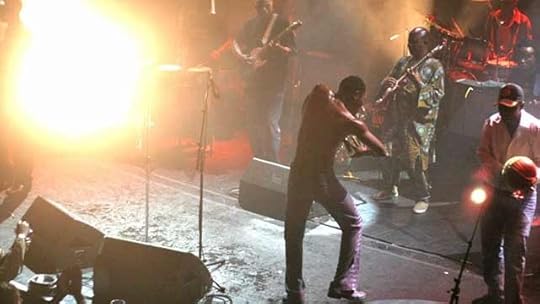
Take it with your vitamins. K'Naan and Nas's "Nothing to Lose" video qualifies. So does Spoek Mathambo remixing Seun Kuti. Kuti tours the US this summer and Mathambo has a new album coming out in a few weeks. This track, "The Good Leaf," is the last track on Kuti's latest release, "From Africa with Fury: Rise" and was posted on The Fader's soundcloud account this week. You can download it for free, but here's the track anyway:








Sean Jacobs's Blog
- Sean Jacobs's profile
- 4 followers







